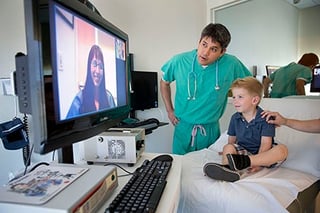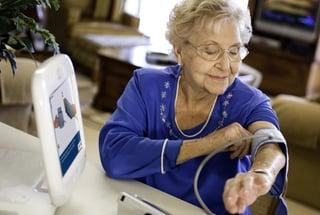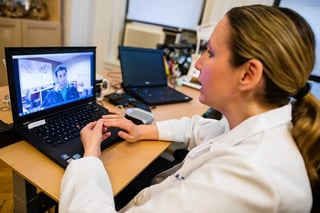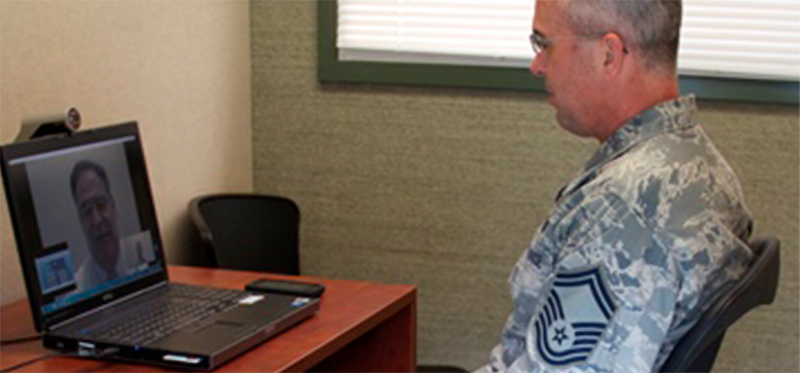The telehealth/health IT industry is in an endless state of innovative disruption, spurred by start-ups, innovators, and technologists rethinking how best to address today’s healthcare needs and improve the patient/doctor experience. In an age when the term “design thinking” has seeped into so many different industries, there is ample opportunity to rethink culture, space, and connectivity and center this on the user experience.
Rethinking telehealth connectivity relates to the redesign of other medical-related technologies as well, such as mHealth and Wearable Health devices. The required connectivity between these products will likely redefine the overarching communication system used to distribute and process the data and resulting insights related to a patient’s health.
This rethinking of culture and space has led to technological advancements in remote patient monitoring, virtual doctor visits, and the increased use of electronic medical records (EMRs). Virtual doctor visits give people living in rural areas access to a wide variety of medical professionals, even though they might be located hundreds of miles from a patient’s residence. And EMRs follow patients throughout their lives — even if they change from one primary care physician to another — making it easy for a physician to access a patient’s medical history.
The growing trend in telehealth has companies introducing products like Salesforce’s Health Cloud, which seeks to make the patient/doctor experience more about “patient relationships, not records,” says Dr. Joshua Newman, chief medical officer and general manager of Salesforce Healthcare and Life Sciences. But when thinking about patient/doctor relationships, it’s important to consider the different types of users who stand to benefit from telehealth technologies, and the important things to consider when developing technologies for these users.
Military and veteran populations could greatly benefit from telehealth technologies, considering that they’re located all over the world, in critical situations that place them in physical and psychological danger, and are often put into emergency situations that require immediate point-of-care solutions. A recent article in mHealth News details mHealth and telehealth initiatives that are outlined in the 2016 budget proposal for the Department of Veterans Affairs (VA). More than $1 billion is being put toward these initiatives, many of which focus specifically on mental health treatment, as it is hoped that telehealth systems can help to maintain and improve the treatment of veterans with PTSD and other stress-related conditions. About $30 million is going to interoperability initiatives and $230 million to upgrades to the VA’s EMR system. These upgrades would assist in streamlining the MyVA portal that gives veterans access to VA services from various locations and devices, allowing veterans more involvement in their care and giving medical professionals a better understanding of their needs.
 Pediatric patients represent another group that can benefit from telehealth technologies, considering that this population often has special healthcare needs that require consultation from specialists who may not be local to where their families live. A report from the American Academy of Pediatrics pointed out that “there is a significant disparity in the geographic distribution of pediatric physicians across the country, resulting in many underserved regions…most commonly found in rural regions, but can include suburban and urban settings.” Telemedicine can offer pediatric physicians the ability to treat and consult with a greater number of patients, resulting in decreased wait times and reducing the need for pediatric patients to travel long distances for treatment.
Pediatric patients represent another group that can benefit from telehealth technologies, considering that this population often has special healthcare needs that require consultation from specialists who may not be local to where their families live. A report from the American Academy of Pediatrics pointed out that “there is a significant disparity in the geographic distribution of pediatric physicians across the country, resulting in many underserved regions…most commonly found in rural regions, but can include suburban and urban settings.” Telemedicine can offer pediatric physicians the ability to treat and consult with a greater number of patients, resulting in decreased wait times and reducing the need for pediatric patients to travel long distances for treatment.
 Elderly patients can benefit from telehealth, especially in the context of home healthcare. An increasing number of seniors are living with chronic diseases and rely on health monitoring devices that are easy and safe to use in the comfort of their own homes. Physicians rely on these devices to collect information that they can view in real time or refer to during an appointment with the patient. Additionally, telehealth technologies like videoconferencing offer physicians the ability to conduct remote-access virtual consultations, creating a huge benefit for older populations with significant mobility challenges. They now have the option of speaking with a doctor from home instead of having to travel to a doctor’s office. The increasing adoption of telehealth systems and home healthcare devices is also driving the need for training in the use of these products, which leads to greater awareness by patients as to the state of their own health.
Elderly patients can benefit from telehealth, especially in the context of home healthcare. An increasing number of seniors are living with chronic diseases and rely on health monitoring devices that are easy and safe to use in the comfort of their own homes. Physicians rely on these devices to collect information that they can view in real time or refer to during an appointment with the patient. Additionally, telehealth technologies like videoconferencing offer physicians the ability to conduct remote-access virtual consultations, creating a huge benefit for older populations with significant mobility challenges. They now have the option of speaking with a doctor from home instead of having to travel to a doctor’s office. The increasing adoption of telehealth systems and home healthcare devices is also driving the need for training in the use of these products, which leads to greater awareness by patients as to the state of their own health.
 Physicians also benefit from technologies like remote patient monitoring and EMRs, and from interactions like virtual patient visits. EMRs enhance the ability of physicians to quickly access patient information from virtually any location. They also promote consistent care compliance by creating a single location from which to retrieve a new patient’s past medical history as the patient is treated among various facilities and by different doctors. This is especially important for patients suffering from chronic conditions. Telehealth technologies also help to reduce the frequency of ER visits, and can free up physicians to devote more time to patients. However, physicians continue to be concerned about the usability aspects of these technologies and the ability of EMRs to achieve interoperability between software platforms. Recent government figures mentioned in an article by CIO show that “48 percent of physicians have adopted EMRs, while electronic records are in place at 59 percent of hospitals.” EMRs should be capable of getting the most meaningful patient information/data to the right people at the right time, and in a perfect world would be able to function seamlessly across hundreds of different organizations.
Physicians also benefit from technologies like remote patient monitoring and EMRs, and from interactions like virtual patient visits. EMRs enhance the ability of physicians to quickly access patient information from virtually any location. They also promote consistent care compliance by creating a single location from which to retrieve a new patient’s past medical history as the patient is treated among various facilities and by different doctors. This is especially important for patients suffering from chronic conditions. Telehealth technologies also help to reduce the frequency of ER visits, and can free up physicians to devote more time to patients. However, physicians continue to be concerned about the usability aspects of these technologies and the ability of EMRs to achieve interoperability between software platforms. Recent government figures mentioned in an article by CIO show that “48 percent of physicians have adopted EMRs, while electronic records are in place at 59 percent of hospitals.” EMRs should be capable of getting the most meaningful patient information/data to the right people at the right time, and in a perfect world would be able to function seamlessly across hundreds of different organizations.
How can users’ concerns be resolved and their needs incorporated into future telehealth technologies? Here are some suggestions for how developers could address usability concerns:
- Consider the physical needs and limitations of an aging population and develop technologies that account for their potential auditory/visual/memory/motor impairments and technical experience levels.
- If technologies are being developed for in-home use, consider the space that a product will require, available power sources, the need for wireless connectivity, etc.
- Consider the amount of data and information that is presented to the user. For example, a large amount of information may be overwhelming or unnecessary to an elderly user, but may be informative and appreciated by their caretaker.
- Develop training plans as necessary, keeping your user in mind.
- Include options that incorporate a multidisciplinary approach for healthcare professionals (HCPs), allowing them to consult other HCPs as they see fit before offering treatment options or making a potential diagnosis.
- Realize that technologies developed will be accessed by patients with chronic conditions who may require extra assistance utilizing and interacting with the technologies.
- Physicians naturally seek out technologies that reduce workflow and increase efficiency while giving them confidence that they’re delivering their patients safe, high-quality care. In a TEDMED talk entitled “The Human Factor,” UK physician Pritpal Tamber discusses physicians’ general resistance to change and their feelings of doubt and cautiousness when encountering new technologies. Physicians will be resistant to technologies that are unreliable, increase the steps involved in working with patients, or interfere with their ability to make decisions related to patient treatment.
